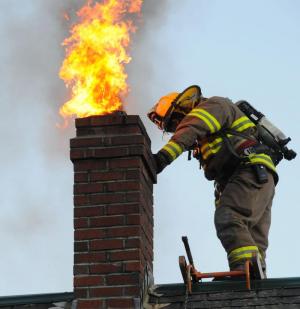Each fall and winter season, WPFD responds to several emergency calls and home fires involving fireplaces, chimneys and home heaters. The use of combustible fuel inside a home is a traditional and effective way to battle freezing temperatures. Not only does a fireplace or wood stove feel great on a chilly night, it also take some of the pressure of your home heating system by reducing the dependence on costly electric or propane/natural gas heating units; However, using an alternative heating source comes with some big responsibilities to ensure that they are properly maintained and operating in a safe manner. Keeping your fireplace, wood stove, pellet stove, and chimney/stovepipe clean is of the highest importance. Failure to get your homes fire fueled heat system inspected and cleaned each year can lead to prevent potential leaks of fire, smoke, and harmful gases from the exhaust system (vent or chimney) into the home or attic causing dangerous conditions. Don’t risk fire, loss of your home, or death from carbon-monoxide leaks. Get your system inspected and cleaned to ensure your home is ready for a full cold season of safe heating!
Safe Home Heating–
- Heating fires account for 36% of residential home fires in rural areas every year.
- Most fire fueled heating failures are due to creosote buildup in chimneys and stovepipes.
- All home heating systems (including electric and natural gas) require regular maintenance to function safely and efficiently.
- Have your chimney or wood stove inspected and cleaned annually by a certified chimney specialist.
- Clear the area around the hearth of debris, decorations and flammable materials.
- Leave glass doors open while burning a fire. Leaving the doors open ensures that the fire receives enough air to ensure complete combustion and keeps creosote from building up in the chimney.
- Close glass doors when the fire is out to keep air from the chimney opening from getting into the room. Most glass fireplace doors have a metal mesh screen which should be closed when the glass doors are open. This mesh screen helps keep embers from getting out of the fireplace area.
- Always use a metal mesh screen with fireplaces that do not have a glass fireplace door.
- Install stovepipe thermometers to help monitor flue temperatures.
- Keep air inlets on wood stoves open, and never restrict air supply to fireplaces. Otherwise you may cause creosote buildup that could lead to a chimney fire.
- Use fire-resistant materials on walls around wood stoves.
Build A Better Fire–
- Never use flammable liquids to start or rebuild a fire in your fireplace or wood stove.
- Use only seasoned hardwood. Soft, moist wood accelerates creosote buildup.
- Build small fires that burn completely and produce less smoke.
- Never burn cardboard boxes, trash, plastic or debris in your fireplace or wood stove.
- When building a fire, place logs at the rear of the fireplace on an adequate supporting grate.
- Never leave a fire in the fireplace unattended. Extinguish the fire before going to bed or leaving the house.
- Soak hot ashes in water and place them in a metal container outside your home.
Outside Your Home–
- Stack firewood outdoors at least 30 feet away from your home.
- Keep the roof clear of leaves, pine needles and other debris.
- Cover the chimney with a mesh screen spark arrester.
- Remove branches hanging above the chimney, flues or vents.
Inside Your Home–
- Install smoke alarms on every level of your home and inside and outside of sleeping areas. Test them monthly and change the batteries at least once a year. Consider installing the new long life smoke alarms.
- Provide proper venting systems for all heating equipment.
- Extend all vent pipes at least three feet above the roof.

